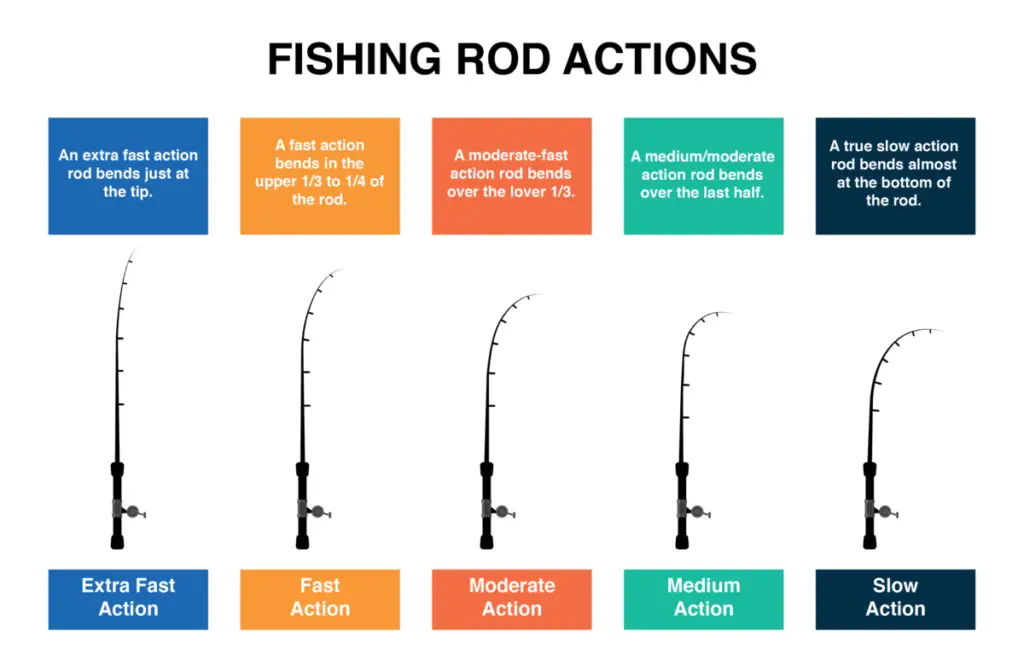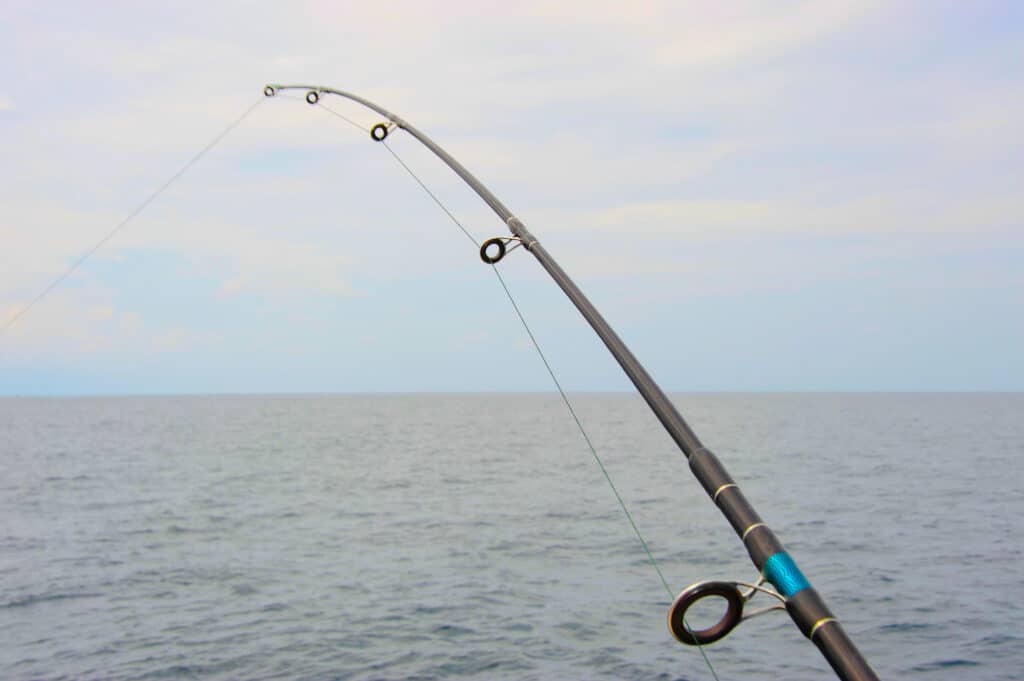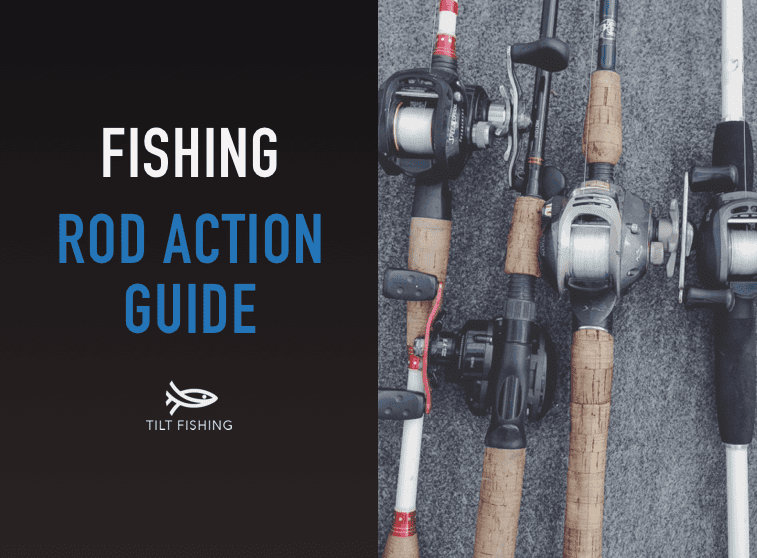When choosing a fishing rod that matches your specific fishing style and needs there are many things to consider. Perhaps one of the most important characteristics to any fishing rod is the action that it has.
If are new to fishing or are looking to purchase a new rod you might be wondering what does the action mean on a fishing rod and which action of rod should you be using for your angling method.
The action of a fishing rod is how much of the rod bends when pressure is put on the tip. Or in other words the action of the fishing rod is where in the rod blank the bend actually happens when pressure is applied. The most common rod actions are extra fast, fast, moderate, and slow. Slow action rods will bend further down the rod blank while faster actions will bend closer to the tip. Slow action rods are generally best for fighting smaller fish and fast action rods are better suited for larger fish or for greater sensitivity.
Understanding and selecting the right rod action for the baits, lures and techniques you’ll be using will help you get the most out of your fishing rod.
In this complete guide to fishing rod actions you’ll learn everything you need to about the action of a fishing rod as well other important factors to consider such as rod length and power.
This information will help you better understand how fishing rods are designed and will help you to choose the right rod action for you and your fishing.
Let’s get started.
Fishing Rod Action Explained
The action of a fishing rod is a rating that simply describes how fast the rod bends when pressure is applied to the tip and the speed with which the rod returns to a neutral position.
A rod’s action is basically how flexible the rod is. The slower the action the more flexible it is and will bend further down the rod blank. The faster a rod’s action the closer it will bend toward the tip of the rod.
How a rod is constructed and the material used impacts it’s action. The most common rod actions are fast, moderate and slow. However, some rods manufactures break down their rods action even further to include models of rods that have extra fast, medium fast, moderate fast, etc.
Each rod action will bend at a different place of the rod. The extra bend or lack thereof each has its own benefits and uses. A rod’s action impacts things like casting distance, how much pressure can be applied to the fish, and the size of baits and lures that will be best used.
A fishing rod that has a fast action means that the tip of the rod is more flexible than the rest of the rod. A rod that has a slow action is a rod that bends further down the rod blank. Meaning they are more flexible.
Fast action rods are the most effective when targeting larger fish with bigger baits. They are typically more sensitive and are paired with more power. Making it easier to put pressure on big fish.
Rod’s that have a slow action are much more forgiving and ideal when using light line, tackle and treble hooked baits. Slower action rods are a favorite among anglers targeting smaller fish or when using finesse fishing methods. Another benefit to a slower action rod is you can cast baits and lures further due to its parabolic bend.
Fishing Rod Action Chart

Here that the most common rod actions and some information on the benefits of each.
Fishing Rod Actions
- Extra Fast Action – An extra fast action rod bends just at the tip.
- Fast Action – A fast action bends in the upper 1/3 to 1/4 of the rod.
- Moderate Action – A moderate-fast action rod bends over the lover 1/3.
- Medium Action – A medium/moderate action rod bends over the last half.
Extra Fast Action Rod
Have little bend at the tip of the rod. Best used for vertical fishing presentations such as jigging and live bait or power techniques. You get more sensitivity and less bend with an extra fast rod.
Fast Action Rod
A fast action rod means that when pressure is applied, only the upper third or fourth of the total rod blank will bend or flex. Basically these rods are pretty stiff and will only bend at the top of the rod. Extra fast or fast rods are more sensitive and generally have more power.
Fast action rods are versatile and used for a variety of fishing applications. You get a balance of good sensitivity and decent casting distance. They are ideal for most applications where a short to long casting distance is required. They are also a popular rod action for anglers targeting larger fish or when fishing vertically.
Moderate/Medium Action Rod
A medium or moderate action rod bends near the top half of the blank. They are a good combination of casting distance, sensitivity and power. They match up well with lures that have a single hook.
Medium action rods are best for crankbaits, top water lures, chatter baits and other reaction style lures. They give anglers a little more casting distance but still provide enough power for a good hook set.
Slow Action Rod
Slow action rods are more flexible and have more parabolic bend. They are best used for lures that have multi-hooks such as crankbaits, jerk baits and other reactive type of lures. They are typically less sensitive but can achieve a longer casting distance.
Best Action for a Fishing Rod
At this point you know have a solid understanding of what rod action means on a fishing rod. However, you still might be wondering what is the best action for a fishing rod? And which ones should I use in my fishing. This is an important question that all anglers need to understand.
The best rod action will vary depending upon your angling method, size of lures or baits you are using and what your target species is.
If you are a beginning angler and just want to get a rod that is versatile and will allow you to do most everything than the best rod action to get is a medium or fast action rod. A medium power fast action rating will allow you to fish most lure and baits effectively.
However, the best rod action can vary quite a bit depending upon the factors I mentioned above.
Here are some of the best rod actions based upon the different angling methods:
Bass Fishing
Selecting and fishing with the right action rod that matches with your bass fishing baits and lures can be extremely important and will make a big difference in your fishing success.
Perhaps the most versatile and best all-around action to have on a bass fishing rod is a moderate or medium action rod. A medium action rod will bend in the top half of their length allowing bass fishing anglers to fish with a wide range of baits, lures and different techniques.
You can use a moderate action rod for throwing crankbaits, jigs, spinnerbaits and most other baits and lures. If you are looking for a great overall rod moderate or medium action rods are the way to go.
If are looking for the best rod action to use for fishing heavy jigs, Texas rigs and punching setups a fast action rod is better suited. A fast action rod bends closer to the tip of the rod and typically are built with more power.
Fly Fishing
Fly fishing rods come in all shapes, lengths and sizes. The right action to use in fly fishing depends upon your presentation and fishing conditions.
The best all-around fly fishing action to use is a medium – also often called a moderate action. They are a do everything versatile rod that gives anglers a good mix of sensitivity and backbone when throwing heavier flies and fighting larger fish.
Slow action fly rods are super flexible and bend around the middle of the blank. This flexibility makes casting easier (unless it’s in the wind) and it more forgiving if you make a mistake.
Slow action fly rods are mainly used and made for anglers throwing dry flies. However, if you are fishing big water where long casts are key or there is a lot of wind they aren’t the best choice
For more insight on selecting the right fly fishing rod action check out this article: What Rod Action is Right for Me?
Ice Fishing
Much like other fishing techniques rod action is an important consideration as it impacts how you can present lures and play the fish.
Most ice fishing anglers opt to use a fast or medium action rod instead of a rod that has a slow action. Slow action rods lack sensitivity to detect bites and strength to get fish through an ice hole when hooked.
For best results choose an ice fishing rod action and power that matches your targeted species and fishing techniques. In general, ultra-light rods are best for pan fish and light to medium rods are good for walleye, and trout. While heavier rods are best for pike and like trout.
For more information on choosing the right fishing rod for ice fishing check out this article: Choosing the Perfect Ice Fishing Rod.
How to Check Action of a Fishing Rod

Checking or finding out the action of a fishing rod is really easy. Most rod manufactures will print the action of the rod near the handle. They will also include the power, lure and line rating. All of which are important factors that can impact performance.
Another easy way to check the action of a fishing rod is to simply flex it against the ground. Just make sure the rod guides are facing upwards and that you don’t apply to much pressure. By flexing it against the ground you can at where the rod starts to bend.
The higher or closer to the tip of the rod it bends the faster the action the rod has. If it bends more towards the middle of the rod blank it’s a moderate or medium action rod. If it super flexible and bends more towards the middle and below it’s a slow action fishing rod.
Along with that when you purchase a fishing rod online they will have all of this information in the product description so you can now exactly the type of rod you are getting.
Fishing Rod Power
Another important factor to consider when selecting the right rod is the rod’s power. Fishing rod power is essentially the amount of pressure or force needed to bend the rod at its action rating.
Lighter power rods are used for light weight tackle and when targeting smaller sized fish. Medium powered rods are more of bass and walleye anglers. Where heavier power rods are designed for big bass, big baits, pike and catfish.
Here are the most common rod powers used by most rod manufactures:
Ultra-Light
Ultra-light powered rods are ideal for subtle finesse presentations when using light line and lures. Ultra-light rods are popular to use when targeting panfish, crappie and smaller sized trout.
Light
Light rods are a small step up from a ultra-light and are best to use when using lures in the 1/16- ounce range. These rods are also best to use when targeting panfish, walleye, and most trout.
Medium Light
A medium powered rod is ideal for lures in the 1/8 to 1/3-ounce range. These rods are used by both fresh and saltwater anglers. These rods will stiffen up quicker and allow for a faster hook set when using jigs and soft plastic baits.
Medium
A medium powered rod is one of the most versatile rod powers and gives anglers a lot of options. They are ideal in bass fishing when throwing spinnerbaits, crankbaits and other moving baits, but are also popular in fresh water when popping corks. In general, they are good to use when throwing lures and baits in the ¼ to ¾ ounce range.
Medium Heavy
If you ask most bass fishing anglers what their favorite rod power is it would be a medium heavy rod and is one you would see the most on the deck of their boat. They are a little stiffer and more powerful than a medium rod which makes it easier to fish around vegetation and structure. If you are looking for your first bass fishing rod than a medium heavy powered rod is a great choice.
Heavy
A heavy rod is built to handler larger and heavier baits around the 3/8 to 1-ounce range. As a result, its ideal for heavier jigs and lures and deep structure fishing. It’s a popular rod power in bass fishing as well as for other larger harder fishing fish.
Extra Heavy
The stiffest and heaviest built rod in most rod lineups is an extra heavy rod. These rods are built for heavy line, large baits, and big fish. When you bust out an extra heavy rod you mean business and you are after a large bass, muskie or lake trout.
Fishing Rod Action vs. Power
A fish rod’s action and power are two important features that work together to create the right amount of bend and power of a fishing rod.
As I mentioned before a fishing rod power is how much force it takes to bend the fishing rod. The action of a fishing rod is where the rod bends. Each fishing rod will have both an action and a rod power. Fish rod manufactures will different combinations of rod action and power to create the ideal rod for each fishing application.
Final Thoughts
A fishing rod action is an important thing to consider when choosing a fishing rod regardless of your target species and fishing method.
The right action of rod and equipment needed will depend upon the size of the fish and the flies, baits and lures you’ll be using.
To ensure you fish with and choose the right rod it’s important that you familiarize yourself with all of the rod features and be aware of their differences.
Feel free to reference this article anytime you need to make a rod decision so you’ll be confident you fish with and choose the right rod for your next fishing adventure.

